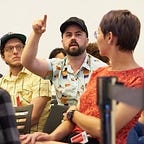Ship the Ship That Ships the Best for the Guest
Asset, Boundary, Narrative Analysis: the Washington State Ferries don’t need to be a drag
I ride the Washington State Ferries for 2 hours every day. I have other, slightly more expensive options, but this is the boat I’m in for now (pun very much intended).
To lay a baseline, let’s take a look around the Ferry system:
Assets:
- Twenty-two ferries: The fleet (I mostly ride on the Chimicum and the Kaleetan, if you’re curious)
- 1800 dedicated employees
- Tens of Millions of captive, idle passengers for between 30–60 mins, twice a day
- Alcohol sales
- Miles of scenic views
- Monopoly on transit routes
Boundries:
Twenty-two ferries cross Puget Sound and its inland waterways, carrying more than 22 million passengers to 20 different ports of call.
State Transit operation, responsible to voters.
Due to a bill back in 2000, the ferry system has been severely limited in its ability to reinvest, because it chose to rely heavily on public funding for operations.
Narrative:
- We are a boring commuter service that some tourists like to visit.
- We deserve taxpayer dollars to pay for our system because taxpayers use it.
- We ferry low-wage earners into the rich neighborhoods for the workday and bring that revenue back to the Olympic Peninsula.
From Tacoma, Washington, to Sidney, British Columbia, we travel up and down the Sound, acting as a marine highway for commercial users, tourists and daily commuters alike.
Goals:
- Freedom from budget cuts
- maintenance revenue
- capital projects revenue
- dare we say profitability??
Reframing for fun and profit
There’s a disconnect with the narrative that because taxpayers use a service, that it automatically becomes something that needs to subsist on tax revenue. I can’t help reading some of the above documents and rub my furrowed brow while I think:
“Taxpayers eat at McDonald’s and fly LEAR JETS, but taxes aren’t keeping those businesses open. The Magic Kingdom doesn’t worry about budget cuts from Anaheim. Why is the ferry system hamstrung by a bill from 2000?”
I work with other boats at my day-job, so this is actually in my wheelhouse.
There are a bunch of historical lessons to learn about industries on the brink of extinction that pivot and find new life. Most, if not all of those stories are about finding new stories, new audiences, new purposes, and inevitably, new revenue.
Mostly they just need a new narrative for themselves.
WSF 3.0:
New framing
- Spend your time well
- Live a better life on the Peninsula
- Party boat
- Stay engaged with your surroundings
- See the beauty Washington has to offer
- #ferrylife is a desirable state of being
- state’s best bar — stunning views and best cocktail waiters, mingle with tech giants
- culinary craft- seafood on the sea- What could be fresher??
New customer focus
- Smart, educated people take the ferry
- Tech geniuses are a prime target, what do they want out of a 30–60 minute trip?
- User research laboratory
- micro transactions
- Value-aligned services
- greater level of self-service
- community building opportunities
- Amazing experiences for tourists
- suite of personal & professional services guests don’t have time for
- wi-fi
New why
- Water travel is amazing
- driving is dumb
- Ecological impact (might have to improve this)
- Escape the concrete jungle
- optimize your time
New tools
- wi-fi (yes again. this is important to me)
- Guided audio tours triggered by GPS waypoints
- a gym
- a barber
- an app
- attention to detail with food and drink
- customized journeys
- elite services to subsidize low fares
- Children’s area, quiet rooms for grumpy adults, listening rooms for new releases
- reserved seating
- car maintenance and oil changes on demand
What appears to cripple the current narrative is an unwillingness to see the breadth of human experiences as valid. In an effort to appear as an unbiased public service, the experience is relatively draconian and socialist. No tall poppies. No fun.
When you look at some of the amazing assets they have at their disposal, it’s hard to believe that so few of them have been properly leveraged. Can you imagine what you would do with that captive audience? What good could you do with 1800 staff? What experiences can you imagine across a fleet of 22 ships?
Almost all of the constraints that keep the service clunky, chincey, and debt-ridden are self-imposed constructs (albeit “self” here means the population of the state). I’m being glib here for a purpose — I know political challenges can be formidable. However, if this system is truly by the people and for the people, wouldn’t it be great to honor those people and the quarter of their workday they spend in these floating faraday cages?
Wouldn’t it be dignifying if we could love the experience instead of tolerating it?
More where this came from
This story is published in Noteworthy, where thousands come every day to learn about the people & ideas shaping the products we love.
Follow our publication to see more product & design stories featured by the Journal team.
